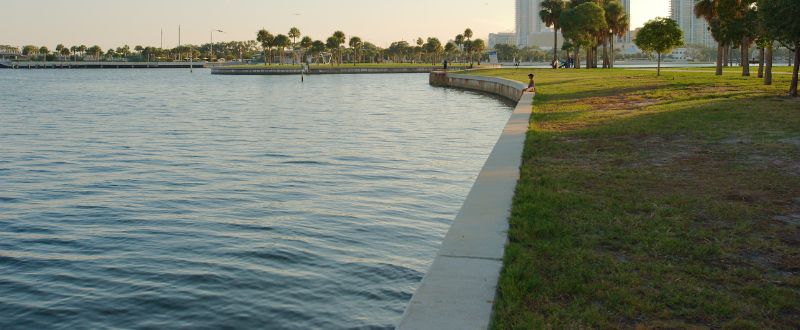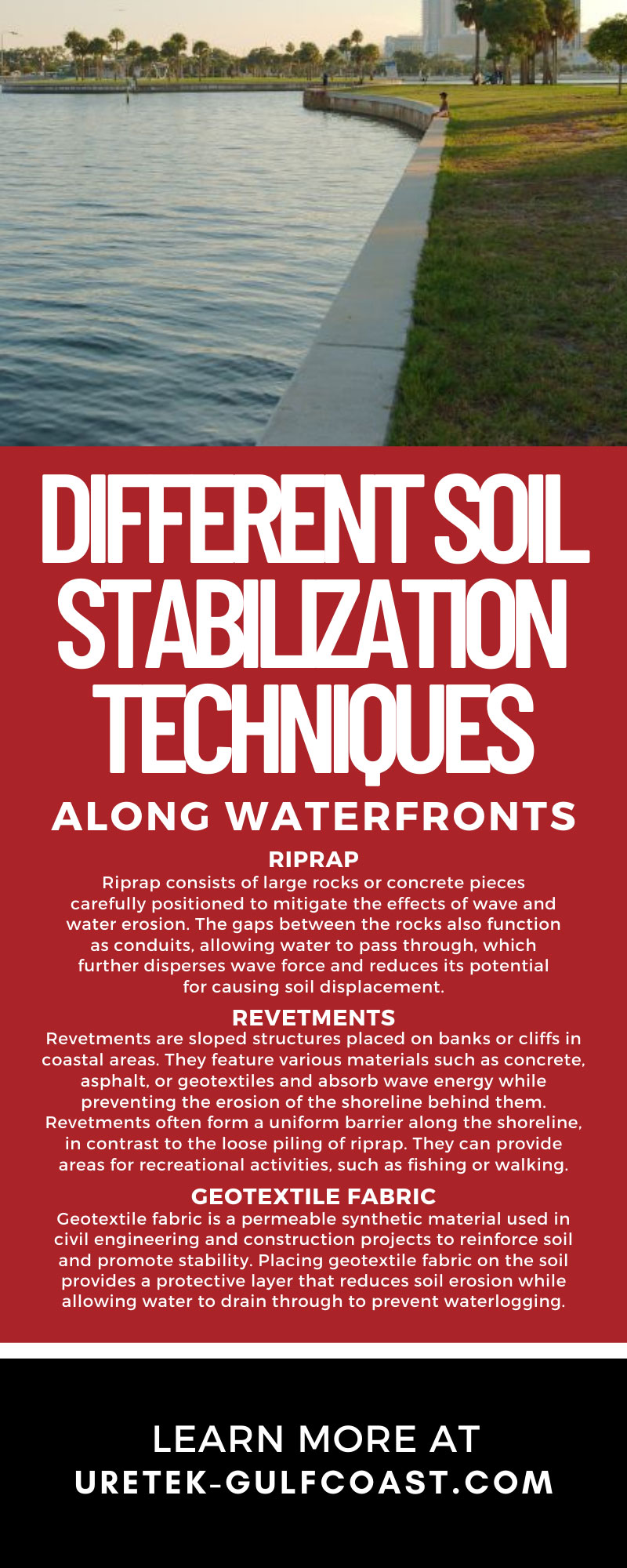The integrity and longevity of waterfront structures and natural landscapes depend significantly on soil stabilization. Shoreline management involves various techniques to prevent erosion and provide stability in these critical areas.
Waterfront areas host complex ecosystems and are subject to continuous change due to water movement. Stabilizing these areas is crucial to preventing erosion, safeguarding habitats, and maintaining the integrity of infrastructure. Explore different soil stabilization techniques along waterfronts, their strengths, and their limitations.
Riprap
Riprap consists of large rocks or concrete pieces carefully positioned to mitigate the effects of wave and water erosion. Placed in strategic formations along shorelines, riprap absorbs and dispels wave energy that would otherwise directly impact soil stability. The gaps between the rocks also function as conduits, allowing water to pass through, which further disperses wave force and reduces its potential for causing soil displacement.
Besides its functional advantage, riprap placement can integrate aesthetically with the natural landscape. Improperly installed riprap can trigger adverse effects downstream or on adjacent properties, so it’s essential to ensure proper sizing, placement, and sourcing of materials.
Revetments
Revetments are sloped structures placed on banks or cliffs in coastal areas. They feature various materials such as concrete, asphalt, or geotextiles and absorb wave energy while preventing the erosion of the shoreline behind them. Revetments often form a uniform barrier along the shoreline, in contrast to the loose piling of riprap. They can provide areas for recreational activities, such as fishing or walking.
Revetments require regular inspection and maintenance to address any wear, displacement, or damage caused by wave action and weather conditions. Property owners or coastal management authorities perform maintenance, including reinforcing weakened areas and replacing eroded materials, annually or after significant storm events to ensure their effectiveness and longevity.
Geotextile Fabric
Geotextile fabric is a permeable synthetic material used in civil engineering and construction projects to reinforce soil and promote stability. Placing geotextile fabric on the soil provides a protective layer that reduces soil erosion while allowing water to drain through to prevent waterlogging.
This simple solution may not be suitable in areas requiring heavy load support or in locations experiencing very aggressive erosion. More robust solutions, such as hard engineering structures, can better withstand these conditions and offer greater resistance to extreme weather events.
Bulkheads
Companies specializing in coastal and marine construction erect bulkheads along shorelines, rivers, or lakes to prevent erosion by creating a barrier between the water and the land. They typically feature materials such as wood, steel, concrete, or vinyl and serve to stabilize the soil, protect property, and sometimes enhance the aesthetics of waterfront areas.
Resilient but Not Impervious to Damage
While bulkheads are highly effective, over time, water can flow through or under the structure. When this happens, the water gradually erodes the soil behind the bulkhead and creates voids. Voids compromise the integrity of the bulkhead, potentially leading to collapse or significant damage.
A bulkhead repair company can stop soil loss and stabilize the area by injecting polymer foam into the ground behind the damaged bulkhead. URETEK’s environmentally inert, non-toxic polymer foam expands to fill voids and seal sources of water infiltration. This method not only stabilizes the soil but also helps to restore the bulkhead’s original strength and functionality, thereby extending its lifespan.
Living Shorelines
Living shorelines utilize a combination of plants, stones, and sand to protect, regenerate, and sustain coastal ecosystems. Plant root systems help to bind the soil, while the presence of sand and stones buffers wave action.
Living shorelines may not be suitable in locations exposed to high wave energy or heavy boat traffic, which can overwhelm natural defenses. Moreover, establishing a living shoreline can be time-consuming and requires ongoing maintenance to ensure the shoreline develops into a stable and self-sustaining habitat. Despite these challenges, the long-term environmental benefits make the effort of creating living shorelines worthwhile for coastal protection.
Terracing
Terracing stabilizes soil by breaking a slope into a series of stepped, flat surfaces, effectively reducing the gradient and the speed at which water flows over the surface. This slower water movement allows more time for water to infiltrate the soil, thereby reducing runoff and preventing soil erosion.
Moreover, by creating level platforms, terracing provides a stable base for planting. Terracing facilitates water infiltration, helping provide the necessary moisture for growth and nutrient uptake. Vegetation roots further anchor the soil and minimize soil displacement.
Versatile Solutions Stabilize Waterfront Areas
Stabilizing soil on waterfront property demands a versatile approach due to the dynamic nature of aquatic environments, where erosion and water levels can significantly vary across different locations and seasons. Additionally, the need to balance ecological preservation with structural integrity requires a diverse range of stabilization techniques to suit specific site conditions and environmental regulations.
Waterfront soil management techniques range from hard structures like ripraps, revetments, and bulkheads to softer methods such as geotextile fabrics and living shorelines. Successfully integrating these techniques can significantly mitigate erosion threats, protect valuable habitats, and maintain the integrity of waterfront areas for future generations.


